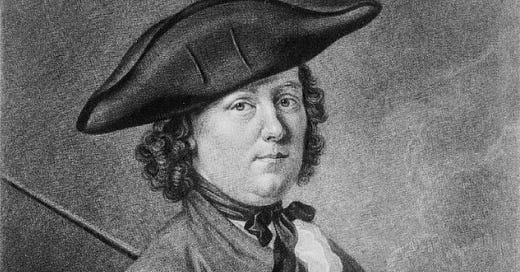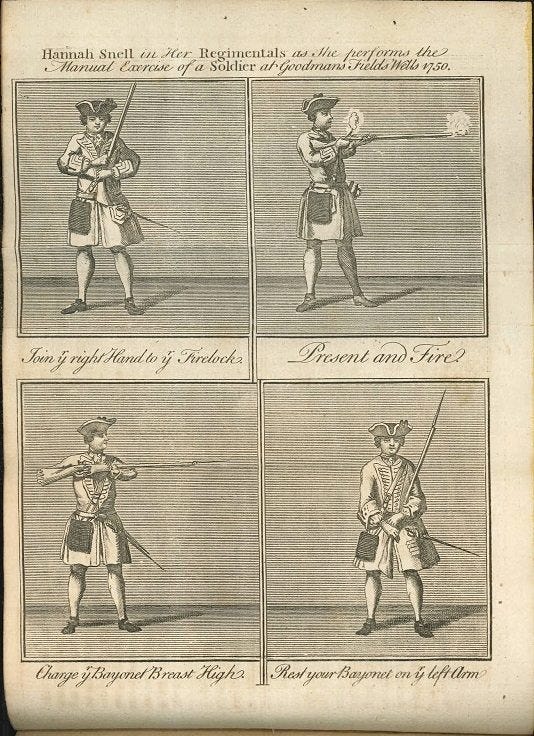Hannah Snell: The Story of a Female Warrior in a Man’s World
Hannah Snell remains one of the most fascinating figures in military history, renowned for her extraordinary decision to disguise herself as a man and enlist in the British Army.
Amidst the rigid societal norms and gender roles of the 18th century, the story of Hannah Snell stands as a fascinating example of extraordinary courage and defiance. In 1747, aged just 22, Snell left home in search of her missing husband. Instead, she found fame.
Born in 1723 in Worcester, England, Hannah Snell’s life began unremarkably enough. The daughter of a dyer and the youngest of nine children, her childhood was comfortable. She often enjoyed playing soldiers as a child, leaving locals to dub her “young Amazon Snell”; however, her contented childhood would come to an end in 1740. Aged 17, both of her parents died, and so she moved to the bustling city of London to live with an older sister. It was here that Snell met James Summs, a Dutch sailor, and they soon wed. The marriage was far from blissful, and according to Snell’s biographer, Summs was a scoundrel.
She had Charms enough to captivate the Heart, and secure the Affection of any reasonable Man, yet she was despised and contemned by her Husband, who not only kept criminal Company with other Women of the basest Characters, but also made away with her Things, in Order to support his Luxury, and the daily Expences of his Whores.
Clearly, Summs was far from an ideal partner. His most egregious act, however, was deserting Hannah when she was seven months pregnant, leaving her to face childbirth alone. Soon after the birth, Snell’s daughter passed away, and Hannah left London in search of her deserting husband—a drastic decision that would alter the course of her life entirely.
Military Career
Upon hearing whispers that Summs had been conscripted into the military, Snell decided to don her brother-in-law, James Gray’s clothing and adopt his identity to enlist in the British army in search of Summs.
Military life in 18th-century Britain was tough, and at times, gangs would forcibly “recruit” men into service. The navy, in particular, was difficult, with disease and a scarcity of provisions making life particularly harsh. Despite this and the fact that she later discovered that Summs had been convicted and executed for murder, she was undeterred from pursuing an adventurous military career. Assuming the guise of James Gray, she enlisted in the 6th Regiment of Foot, finding herself amidst the Jacobite rebellion in Scotland. Here, Snell received her introduction into the rigours of military life, mastering the use of firearms.
Her story took a harrowing turn when she refused to facilitate a sexual encounter between a sergeant and a local girl. As punishment, Snell was subjected to a measure of staggering brutality and sentenced to receive 600 lashes for what was deemed “neglect of duty”. Remarkably, after receiving 500 of these lashes in stoic silence, the commanding officer, perhaps moved by her fortitude, ordered that she be spared the remaining lashes. Snell’s true identity remained undetected.
Following this ordeal, Snell left the regiment behind, ventured to Portsmouth to join the British Royal Marines, and set sail on the Swallow to India. It was in 1748 that she fought in the Battle of Pondicherry, a concerted British effort to seize a French colony. Reports from the time recount how she killed several Frenchmen before sustaining injuries herself. But this wasn’t her only challenge. Having never seen her shave, her crewmates nicknamed her “Miss Molly Gray”. To dispel any suspicions and to maintain her disguise, Snell cunningly began “flirting” with local women. Her military exploits also brought her to the battlefield at Devicotta, where she culminated a tally of twelve wounds. Among these was a musket shot to the groin. To avoid detection as a woman by the ship’s surgeon, Snell perilously operated on herself.
A National Celebrity
In 1750, Snell returned to Britain and finally revealed her true identity to her comrades. Yet, far from shunning her for deceit, her crewmates marvelled at her audacity and courage. They encouraged her to petition the head of the British army, the Duke of Cumberland, to grant her a military pension. The pension was duly granted, and she was honourably discharged from the army. Quickly, word spread throughout Britain about her story. Contrary to what might have been the anticipated rebuke or ostracisation for a woman who had so boldly transgressed the gender norms of the time, Snell was celebrated. The tales of her exploits captivated the public’s imagination, and she soon became the star of her very own stage production and her biography became a bestselling sensation.
In the years that followed, Snell’s life took on a quieter rhythm. She married twice more and had two sons, settling into a domestic life that stood in stark contrast to her years in the military. In his diary, famed Norfolk rector James Woodforde recounts meeting Snell:
We all breakfasted, dined and slept again at Weston -I walked up to the White Hart with Mr. Lewis and Bill, to see a famous Woman in Men's Cloaths, by name Hannah Snell, who was 21 years as a Common Soldier in the Army, and not discovered by any as a Woman -Cousin Lewis has mounted guard with her abroad - She went in the Army by the name of John Gray - She has a pension from the Crown now of 18 - 5 - 0 per Annum and the liberty of wearing Men's Cloaths and also a Cockade in her Hat, which she still wears - She has laid in a room with 70 Soldiers and not discovered by any of them - The forefinger of her right hand was cut of by a Sword at the taking of Pondicherry - She is now about 60 yrs of age and talks very sensible and well, and travels the country with a Basket at her back, selling Buttons, Garters, laces &c. -
I took 4 Pk of 4d Buttons and gave her - 0 - 2 - 6.
Hannah Snell’s life story is a riveting blend of courage, cunning and defiance. Her journey from a deserted wife seeking justice to a celebrated soldier and, later, a cultural icon highlights not just the personal tenacity and resilience of one woman but also the broader capacity for change and acceptance within society.






